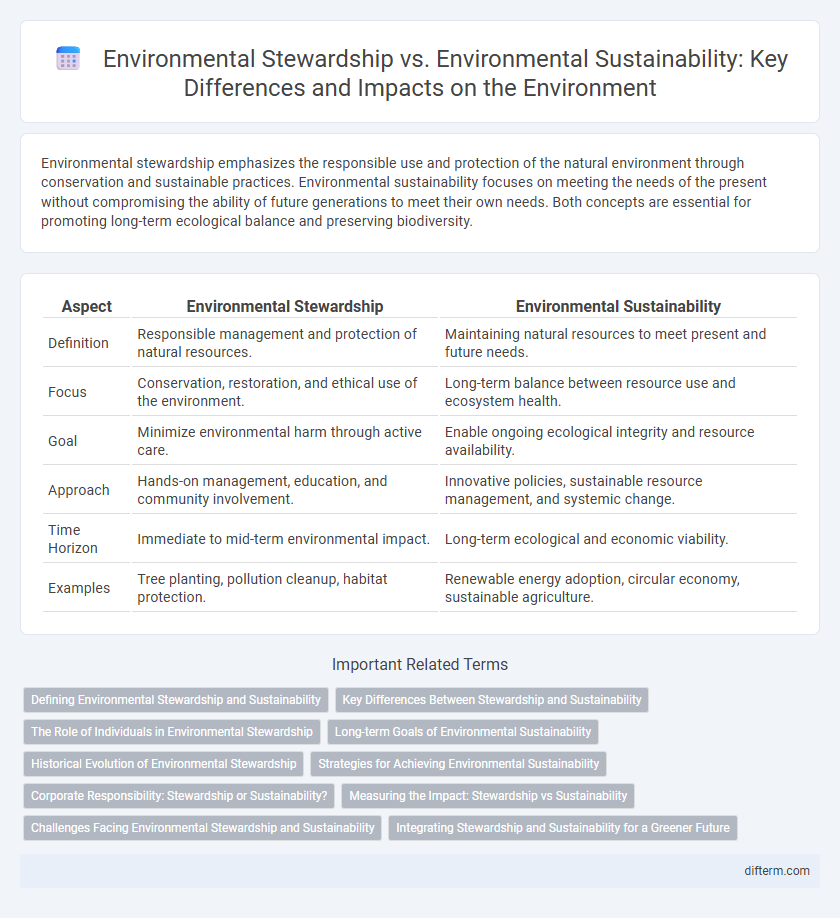Environmental stewardship emphasizes the responsible use and protection of the natural environment through conservation and sustainable practices. Environmental sustainability focuses on meeting the needs of the present without compromising the ability of future generations to meet their own needs. Both concepts are essential for promoting long-term ecological balance and preserving biodiversity.
Table of Comparison
| Aspect | Environmental Stewardship | Environmental Sustainability |
|---|---|---|
| Definition | Responsible management and protection of natural resources. | Maintaining natural resources to meet present and future needs. |
| Focus | Conservation, restoration, and ethical use of the environment. | Long-term balance between resource use and ecosystem health. |
| Goal | Minimize environmental harm through active care. | Enable ongoing ecological integrity and resource availability. |
| Approach | Hands-on management, education, and community involvement. | Innovative policies, sustainable resource management, and systemic change. |
| Time Horizon | Immediate to mid-term environmental impact. | Long-term ecological and economic viability. |
| Examples | Tree planting, pollution cleanup, habitat protection. | Renewable energy adoption, circular economy, sustainable agriculture. |
Defining Environmental Stewardship and Sustainability
Environmental stewardship emphasizes responsible management and care of natural resources to protect ecosystems and biodiversity. Environmental sustainability focuses on meeting present needs without compromising the ability of future generations to meet their own, ensuring long-term ecological balance. Both concepts prioritize conserving natural capital, but stewardship centers on active guardianship while sustainability involves systemic practices and policies.
Key Differences Between Stewardship and Sustainability
Environmental stewardship emphasizes responsible management and protection of natural resources through active care and conservation efforts, focusing on ethical obligations to preserve ecosystems. Environmental sustainability prioritizes meeting present needs without compromising future generations' ability to thrive, integrating long-term ecological balance with social and economic factors. Key differences lie in stewardship's focus on immediate, active guardianship versus sustainability's holistic, enduring framework for resource use and ecosystem health.
The Role of Individuals in Environmental Stewardship
Individuals play a crucial role in environmental stewardship by actively conserving natural resources, reducing waste, and supporting biodiversity through sustainable daily practices. Environmental stewardship emphasizes responsible management and care of the environment, often involving community engagement and advocacy for eco-friendly policies. Personal actions such as energy conservation, recycling, and sustainable consumption significantly contribute to the broader goal of environmental sustainability, ensuring the long-term health of ecosystems.
Long-term Goals of Environmental Sustainability
Environmental sustainability emphasizes long-term goals such as preserving natural resources, maintaining ecosystem health, and reducing carbon footprints to ensure the planet's viability for future generations. Environmental stewardship involves responsible management and care of the environment today, but sustainability aims to create systems that balance ecological, economic, and social factors over time. Key objectives include reducing greenhouse gas emissions, conserving biodiversity, and promoting renewable energy adoption to support enduring environmental health.
Historical Evolution of Environmental Stewardship
Environmental stewardship has evolved from early conservation practices rooted in indigenous cultures to modern frameworks emphasizing responsible resource management and ecological balance. The 20th century marked a significant shift with the rise of environmental movements advocating for protection against industrial pollution and habitat destruction. This historical evolution laid the groundwork for contemporary sustainability principles focused on long-term ecosystem health and intergenerational equity.
Strategies for Achieving Environmental Sustainability
Environmental stewardship emphasizes responsible management of natural resources through conservation, pollution reduction, and community engagement, while environmental sustainability focuses on maintaining ecosystem health for future generations by balancing ecological, economic, and social factors. Strategies for achieving environmental sustainability include implementing renewable energy solutions, promoting circular economy practices, enhancing biodiversity conservation, and enforcing stringent environmental regulations. Integrating technology for efficient resource management and fostering collaboration among government, industries, and communities accelerates progress toward long-term sustainability goals.
Corporate Responsibility: Stewardship or Sustainability?
Corporate responsibility in environmental management often balances stewardship and sustainability, with stewardship emphasizing active protection and restoration of natural resources, while sustainability focuses on long-term resource viability and minimizing ecological footprints. Leading corporations implement comprehensive stewardship programs that incorporate sustainability goals, ensuring responsible resource use and reducing environmental impact across supply chains. Integrating both approaches drives innovation in eco-efficient technologies and transparent reporting practices, aligning business growth with environmental preservation.
Measuring the Impact: Stewardship vs Sustainability
Environmental stewardship measures impact by evaluating immediate resource management practices and community engagement efforts that protect ecosystems. Environmental sustainability assesses long-term effects on biodiversity, carbon footprints, and resource renewal rates to ensure ecological balance for future generations. Quantitative metrics such as ecosystem health indices, emission reduction percentages, and renewable resource utilization rates differentiate stewardship's short-term focus from sustainability's long-term objectives.
Challenges Facing Environmental Stewardship and Sustainability
Environmental stewardship faces challenges such as limited public awareness, inadequate funding for conservation projects, and conflicting economic interests that hinder effective ecosystem management. Environmental sustainability struggles with resource depletion, climate change impacts, and the complexity of implementing long-term policies across diverse geopolitical landscapes. Both require integrated approaches combining scientific innovation, community engagement, and robust regulatory frameworks to address these multifaceted issues.
Integrating Stewardship and Sustainability for a Greener Future
Integrating environmental stewardship with sustainability practices enhances ecosystem resilience by promoting responsible resource management and conservation efforts. Emphasizing both approaches drives long-term ecological balance, reduces carbon footprints, and supports biodiversity preservation. Collaborative initiatives that merge stewardship values with sustainable development foster innovative solutions for climate change mitigation and sustainable living.
environmental stewardship vs environmental sustainability Infographic

 difterm.com
difterm.com